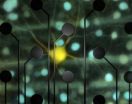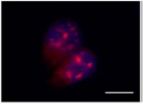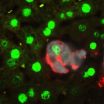(Press-News.org) LA JOLLA, CA—June 5, 2014—A team led by researchers at The Scripps Research Institute (TSRI) has used advanced electron microscopy techniques to determine the first accurate structural map of Mediator, one of the largest and most complex "molecular machines" in cells.
Mediator is crucial for the regulation of most genes' activity and works in the cells of all plants and animals. The mapping of its structure—which includes more than two dozen unique protein subunits—represents a significant advance in basic cell biology and should shed light on medical conditions involving Mediator's dysfunction, from cancer to inherited developmental disorders.
The finding demonstrates how recently developed molecular imaging methods can be applied to characterize large and important protein complexes.
"Being able to determine how these large molecular machines look, how they're organized and how they move, will be critical for a better understanding of many key processes in cells," said TSRI Associate Professor Francisco J. Asturias, the senior author of the study, which was published on June 5, 2014 by the journal Cell.
A Complex Machine
The detailed map of Mediator comes nearly 20 years after the complex was first described by Stanford University biologist Roger Kornberg and colleagues. Kornberg, whose lab members at the time included Asturias, later won a Nobel Prize for his work on the gene transcription machinery of cells.
This gene transcription machinery evolved to perform one of the most basic and routine functions in biology, namely the copying of the information encoded in the DNA of genes into portable RNA "transcripts"—some of which stay and work in the cell nucleus, while others exit the nucleus and are translated into proteins.
Each cell has its own pattern of gene transcription activity, determined by a regulatory system in which Mediator plays an indispensable role. The huge Mediator complex enables transcription factors and other regulatory proteins to influence the RNA polymerase II that actually performs the transcription.
To understand precisely how Mediator does its job, scientists have needed an accurate 3-D model of its architecture, including the locations of all its subunit proteins and a description of the different conformations Mediator can adopt to influence interactions between other components of the transcription machinery.
However, Mediator is enormous by biological standards: the version found in yeast has 25 distinct protein subunits and the human version has 30. It is also highly flexible. That combination of large size, high complexity and high flexibility makes it a poor candidate for high resolution imaging methods such as X-ray crystallography or nuclear magnetic resonance spectroscopy.
As a postdoctoral researcher in the Kornberg laboratory in the 1990s, Asturias helped pioneer the use of "single particle" electron microscopy (EM) for the imaging of large transcription complexes such as Mediator. Single-particle EM requires the taking of thousands of separate EM images of a particle of interest—typically very "noisy" images, which depict a particle in different orientations and perhaps also in a number of different conformations. All these data must be filtered and averaged to reduce the noise and yield useful 3-D pictures. In a 1999 study in Science, Asturias and colleagues used an early form of single-particle EM to determine the first rough structure of the full Mediator complex.
In the decade and a half since then, Asturias's group has continued to use EM techniques to study Mediator. Others have used high-resolution techniques to study individual Mediator subunits or portions of the complex. However, a clear and accurate picture of how the whole structure fits together has been elusive until now.
Turning a Model on its Head
To determine the full structure clearly, Asturias and his colleagues began by producing highly pure quantities of a standard yeast version of Mediator—the purification process itself being a major challenge. They then used this collection of Mediator particles to record roughly 85,000 EM images, which they categorized according to conformation. Averaging these yielded the clearest 3D model yet of the Mediator structure, to a resolution of about 18 Angstroms (1.8 billionths of a meter).
Using various other biochemical analyses, including the subtraction of different protein subunits to see how the EM images changed, the scientists were able to identify the precise locations of yeast Mediator's 25 protein subunits.
This mapping resulted in a comprehensive revision of the old rough model of Mediator's head-middle-tail structure. "After we located all the protein subunits, we realized that the head module is at the top of Mediator, not the bottom as had been thought," said Kuang-Lei Tsai, a postdoctoral fellow in the Asturias Laboratory, who was first author of the study. "These new data have helped us make sense of many previous biochemical observations."
Asturias and Tsai next collaborated with the laboratory of Joan and Ron Conaway—Joan is another Kornberg alumnus—at the Stowers Institute for Medical Research in Kansas City. The Conaway team had been working on human Mediator and now provided pure samples for EM imaging, as well as biochemical analyses of the subunit locations.
This work revealed that human Mediator shares the same broad architecture, implying that this structure has been, for the most part, conserved throughout the billion years of evolution that separate yeast and humans. "Basically the two Mediators have similar overall structure," said Tsai.
In the last part of the study, Asturias and Tsai used the new structural data to show how Mediator likely changes its conformation as it interacts with RNA polymerase on the one hand, and various transcription regulators on the other.
"This study has given us a fairly definitive picture of the Mediator architecture and how the different subunits are organized, so we can start to work towards an atomic resolution model," Asturias said. "We also want to understand better how Mediator interacts with all those other proteins to actually carry out transcription in a regulated manner."
INFORMATION:
In addition to Asturias, Tsai and Joan and Ron Conaway, the co-authors of the study, "Subunit Architecture and Functional Modular Rearrangements of the Transcriptional Mediator Complex," were Chieri Tomomori-Sato and Shigeo Sato, also of the Stowers Institute for Medical Research.
The research was funded in part by the National Institutes of Health (grants R01 GM67167, R01 GM41628) and the Helen Nelson Medical Research Fund at the Greater Kansas City Community Foundation.
Scientists generate long-sought molecular map of critical genetic machinery
Findings will shed light on conditions from cancer to developmental disorders
2014-06-05
ELSE PRESS RELEASES FROM THIS DATE:
Diabetes care depends on how your doctor is paid
2014-06-05
TORONTO, June 5, 2014 – From 2006 to 2008, nearly 75 per cent of Ontarians with diabetes did not receive all of the tests recommended to properly monitor their disease. How their doctor was paid was one of the factors determining the care they received, according to a study by researchers at St. Michael's Hospital and the Institute for Clinical Evaluative Sciences (ICES).
The study, published today in the Canadian Journal of Diabetes, found that patients who were not actively enrolled with a family doctor were least likely to receive optimum diabetes care. The researchers ...
New method reveals single protein interaction key to embryonic stem cell differentiation
2014-06-05
Proteins are responsible for the vast majority of the cellular functions that shape life, but like guests at a crowded dinner party, they interact transiently and in complex networks, making it difficult to determine which specific interactions are most important.
Now, researchers from the University of Chicago have pioneered a new technique to simplify the study of protein networks and identify the importance of individual protein interactions. By designing synthetic proteins that can only interact with a pre-determined partner, and introducing them into cells, the team ...
Research helps clarify how obesity leads to type 2 diabetes, cancer
2014-06-05
New findings about the biological links between obesity, insulin resistance and type 2 diabetes may also shed light on the connection between obesity and cancer, says a scientist at The University of Texas at Dallas.
In a study published online June 5 in the journal Cell, UT Dallas' Dr. Jung-whan (Jay) Kim and colleagues at the University of California, San Diego found that a protein called HIF-1 alpha plays a key role in the development of insulin resistance and type 2 diabetes in obese mice.
The researchers genetically engineered mice to lack the HIF-1 alpha protein ...
New research explains how we use the GPS inside our brain to navigate
2014-06-05
The way we navigate from A to B is controlled by two brain regions which track the distance to our destination, according to new research funded by the Wellcome Trust and published in Current Biology.
The study found that at the beginning of a journey, one region of the brain calculates the straight-line to the destination ('the distance as a crow flies'), but during travel a different area of the brain computes the precise distance along the path to get there.
The findings pinpoint the precise brain regions used and in doing so change how scientists believed we use ...
Our own treacherous immune genes can cause cancer after viral infection
2014-06-05
HPV (human papillomavirus) infection is widely known to induce cancer. Many of the mutations that cause this virally-induced cancer are caused by a family of genes that normally combats viral infections, finds new UCL (University College London) research.
This raises the possibility of developing drugs to regulate the activity of these genes to prevent HPV-associated cancers from developing and reduce the ability of existing cancers to evolve resistance to treatments.
The research, published in Cell Reports, shows for the first time that genes from the 'APOBEC' family, ...
Cellular traffic control system mapped for the first time
2014-06-05
Cells must transport nutrients and messenger cargos through its membrane and transport them within the cell at the correct time and place. This procedure is complex and is regulated with the help of specific genes. If disturbances in the transport mechanism arise, severe diseases, such as diabetes, cancer and diverse neurological pathologies, are the consequence. The discovery of the molecular principles of cellular transport was honored with the Nobel Prize of physiology and medicine in 2013. While knowing the intracellular roads and the functioning of the cars that use ...
Unmasking viral invaders
2014-06-05
If you have it, you probably don't know it. Cytomegalovirus, or CMV, is perhaps one of the biggest pathogens you've never heard of—big, both proportionately and epidemiologically. It contains approximately 200 genes, compared to HIV's paltry 18, and it's everywhere. You can catch it as a preschooler salivating over blocks, or as a teenager experiencing your first kiss. Once you have it, you have it for life.
Good news: If you're healthy, it's harmless. Your T cells keep it in check, and you'll be none the wiser.
Bad news: If you have any medical condition that dampens ...
Making artificial vision look more natural
2014-06-05
In laboratory tests, researchers have used electrical stimulation of retinal cells to produce the same patterns of activity that occur when the retina sees a moving object. Although more work remains, this is a step toward restoring natural, high-fidelity vision to blind people, the researchers say. The work was funded in part by the National Institutes of Health.
Just 20 years ago, bionic vision was more a science fiction cliché than a realistic medical goal. But in the past few years, the first artificial vision technology has come on the market in the United States ...
Discovered a new way to control genetic material altered in cancer
2014-06-05
When we talk about genetic material, we are usually referring to the DNA (deoxyribonucleic acid) that we inherit from our parents. This DNA is the factory where is built a similar molecule called RNA (ribonucleic acid) which produces our proteins, such as hemoglobin or insulin , allowing the lives of our cells. But there is a special group called non-coding RNA that has a more enigmatic function.
The best known is microRNAs, tiny molecules that are responsible for turning on or off our genome like an electrical current switch. Today, an article published in the prestigious ...
A new model of liver regeneration
2014-06-05
Harvard Stem Cell Institute scientists at Boston Children's Hospital have new evidence in mice that it may be possible to repair a chronically diseased liver by forcing mature liver cells to revert back to a stem cell-like state.
The researchers, led by Fernando Camargo, PhD, happened upon this discovery while investigating whether a biochemical cascade called Hippo, which controls how big the liver grows, also affects cell fate. The unexpected answer, published in the journal Cell, is that switching off the Hippo-signaling pathway in mature liver cells generates very ...
LAST 30 PRESS RELEASES:
Stardust study resets how life’s atoms spread through space
Practical education: Clinical scenario-based program development
The impact of family dynamics on eating behaviour – how going home for Christmas can change how you eat
Tracing the quick synthesis of an industrially important catalyst
New software sheds light on cancer’s hidden genetic networks
UT Health San Antonio awarded $3 million in CPRIT grants to bolster cancer research and prevention efforts in South Texas
Third symposium spotlights global challenge of new contaminants in China’s fight against pollution
From straw to soil harmony: International team reveals how biochar supercharges carbon-smart farming
Myeloma: How AI is redrawing the map of cancer care
Manhattan E. Charurat, Ph.D., MHS invested as the Homer and Martha Gudelsky Distinguished Professor in Medicine at the University of Maryland School of Medicine
Insilico Medicine’s Pharma.AI Q4 Winter Launch Recap: Revolutionizing drug discovery with cutting-edge AI innovations, accelerating the path to pharmaceutical superintelligence
Nanoplastics have diet-dependent impacts on digestive system health
Brain neuron death occurs throughout life and increases with age, a natural human protein drug may halt neuron death in Alzheimer’s disease
SPIE and CLP announce the recipients of the 2025 Advanced Photonics Young Innovator Award
Lessons from the Caldor Fire’s Christmas Valley ‘Miracle’
Ant societies rose by trading individual protection for collective power
Research reveals how ancient viral DNA shapes early embryonic development
A molecular gatekeeper that controls protein synthesis
New ‘cloaking device’ concept to shield sensitive tech from magnetic fields
Researchers show impact of mountain building and climate change on alpine biodiversity
Study models the transition from Neanderthals to modern humans in Europe
University of Phoenix College of Doctoral Studies releases white paper on AI-driven skilling to reduce burnout and restore worker autonomy
AIs fail at the game of visual “telephone”
The levers for a sustainable food system
Potential changes in US homelessness by ending federal support for housing first programs
Vulnerability of large language models to prompt injection when providing medical advice
Researchers develop new system for high-energy-density, long-life, multi-electron transfer bromine-based flow batteries
Ending federal support for housing first programs could increase U.S. homelessness by 5% in one year, new JAMA study finds
New research uncovers molecular ‘safety switch’ shielding cancers from immune attack
Bacteria resisting viral infection can still sink carbon to ocean floor
[Press-News.org] Scientists generate long-sought molecular map of critical genetic machineryFindings will shed light on conditions from cancer to developmental disorders




